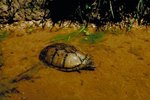The snapping turtle, or Chelydra serpentina, grows to a size of 8 to 12 inches in length, measured on the upper shell. These enormous turtles typically weigh as much as 35 lbs. when fully grown. They make their homes in permanent bodies of fresh water, where they spend much of their time underwater buried in mud. Plants comprise approximately one third of the diet for these omnivores.
Mating
Mating occurs from spring through autumn, generally between April and November. Female snapping turtles can store sperm for several years, allowing annual egg laying and year-round mating. Mating occurs in the water with the eggs later laid on land.
Eggs
Snapping turtles bury their eggs deep in the sand or mud and have been known to travel up to 10 miles in their search for an appropriate nesting site. Females lay up to 80 eggs at a time, with 20 to 30 eggs being more common; eggs take nine to 18 weeks to hatch depending on weather conditions. Eggs often hatch in the fall, though this sometimes occurs in the spring. The gender of the young is determined by the temperature during incubation, with temperatures between 72 and 82 degrees F producing males and temperatures outside this range resulting in females.
Early Life
Snapping turtles provide no care for their young. Females return to the water after burying their eggs on land and do not return when their young hatch. Male and female snapping turtles mature at different speeds, with males considered mature at 3 to 5 years or age and females taking slightly longer, approximately 4 to 6 years. Young snapping turtles may reach a shell length of up to 6 inches in their first year of life.
Lifespan
Wild snapping turtles live approximately three decades, with those in captivity sometimes living longer. Vulnerable when young, snapping turtles may be eaten by mid-sized mammals such as raccoons, various snakes and large birds. Adults have few predators because of their size and aggressive personality. The snapping turtle population remains healthy in most regions and these turtles have been identified in many wetlands.
Reptile Behavior
As a cold-blooded animal, snapping turtles sun themselves to warm their bodies. Unlike other turtles, however, the snapping turtle often remains in the water while doing this, floating at the surface. They become less active as temperatures drop. During winter, snapping turtles bury themselves in mud at the bottom of lakes or ponds and hibernate until spring.
Warning
The shells of snapping turtles are too small for them to pull completely in when attacked. Instead, snapping turtles are surprisingly aggressive and will attack if threatened or provoked while on land. These creatures are not sociable and will usually swim away if approached while in the water.
References
- University of Michigan Museum of Zoology: Chelydra serpentina
- Southeast Missouri State University: Discover Nature Episodes: Snapping Turtles Lay Eggs
- UMass Amherst: The College of Natural Sciences: Snapping Turtles
- University of Michigan: BioKIDS: Snapping Turtle
- Northern State University: Snapping Turtle
Resources
Photo Credits
-
common snapping turtle (chelydra serpentina) image by Bruce MacQueen from Fotolia.com




